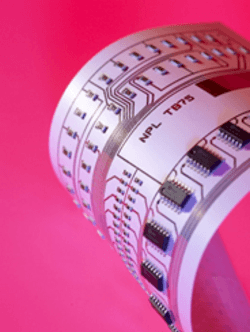Sep 15 2016
Scientists at the National Physical Laboratory (NPL) have developed a new, non-destructive method of detecting the orientation of molecules in organic semiconductor transistors using Raman spectroscopy. This will create a faster and more flexible method of measuring the efficiency of electrical conductivity in a printed circuit, enabling scientists to understand the quality of their devices.
 Current printable electronics mostly use inorganic, non-printed semiconductor components, as shown above. NPL's new test paves the way for these components to also be printed.
Current printable electronics mostly use inorganic, non-printed semiconductor components, as shown above. NPL's new test paves the way for these components to also be printed.
Modern electronic devices such as solar cells can lower costs and weight by using organic semiconductors, in this case organic polymer molecules which conduct electricity, as they can be printed onto thin sheets of plastic material in large volumes. However, printing these polymer molecules means that they can crystallise in all directions which reduces their conductivity. Thus, being able to measure the orientation of these molecules is a crucial part of the quality control process.
Making non-destructive measurements of these molecules has been impossible before now. By using Raman spectroscopy, scientists can observe the way in which a molecule vibrates when light shines on it. Different vibrations cause light reflected from the molecule to have different frequencies. Molecules with different orientations vibrate differently as lasers are passed over them, resulting in a range of frequencies. The technique developed by NPL uses these reflected frequencies to discern the three dimensional orientation of the molecules within the printed circuit.
Using the new test, the efficiency of the production process for electronic devices can be drastically increased making them cheaper, faster and of better quality.
Dr Sebastian Wood, a Higher Research Scientist at NPL, says: "Understanding molecular orientation has been an area of interest to the printed electronics community for over a decade, with various one and two dimensional tests being undertaken. NPL is the first organisation to characterise this important property efficiently and in three dimensions, without destroying the test circuit. We're excited to be the organisation that enables what could be a revolutionary breakthrough in the performance and commercial viability of printable electronics."